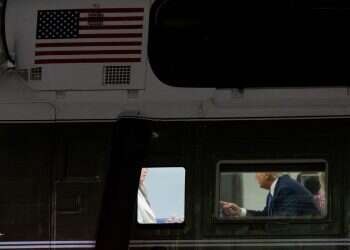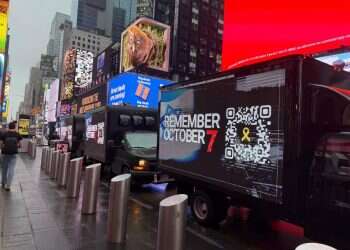Chairman of the International Atomic Energy Agency Rafael Grossi does not intend to set "artificial deadlines" for the closure of an investigation into Iran's military nuclear program, Grossi said Saturday at the end of a meeting with Iran's nuclear chief Mohammad Eslami and Iranian Foreign Minister Hossein Amirabdollahian.
Follow Israel Hayom on Facebook, Twitter, and Instagram
Iran and the IAEA on Saturday agreed a three-month plan that in the best case will resolve the long-stalled issue of uranium particles found at old but undeclared sites in the country, removing an obstacle to reviving the Iran nuclear deal.
Eleven months after indirect talks between Iran and the United States on salvaging the 2015 deal began in Vienna, delegates are trying to settle the final thorny issues within days as Western powers say time is running out since Iran's nuclear advances will soon make the deal redundant.
One unresolved issue, diplomats say, has been Iran's demand for the closure of the International Atomic Energy Agency's investigation into uranium particles found at three apparently old but undeclared sites, which suggest that Iran had nuclear material there that it did not declare to the agency.
The agency has long said Iran has not given satisfactory answers on those issues, but on Saturday they announced a plan for a series of exchanges after which Grossi "will aim to report his conclusion by the June 2022 (IAEA) Board of Governors" meeting, which begins on June 6.
The joint plan clears the way for a possible agreement to revive the 2015 deal, though Grossi emphasized that his conclusion would not necessarily be positive. Where anything other than full resolution would leave implementation of any agreement, however, remains to be seen.
"It would be difficult to imagine you can have a cooperative relationship as if nothing had happened if the clarification of very important safeguards issues were to fail," Grossi said in a news conference when asked what the effect on reviving the deal would be if the issues were not closed.
Grossi also suggested the presentation of his conclusion would happen before "Re-Implementation Day" – the day by which the bulk of US sanctions-lifting and Iranian implementation of nuclear restrictions will have happened under any future agreement – even though they are officially unrelated.
"It is obvious that for Iran it is important to try to have the processes I wouldn't say running in absolute synchronicity, but there is a sort of a loose relationship," he said when asked if the three-month timeframe was based on the timing of Re-Implementation Day.
While the plan provides a roadmap for resolving the agency's open questions about the three sites, the agency removed a fourth open issue from its list - the possible presence in the past of a uranium metal disc at another undeclared location.
A confidential IAEA report sent to member states after Grossi's return and seen by Reuters said the agency had informed Iran that "this issue could be considered as no longer outstanding at this stage", adding that the IAEA "could not exclude that the disc had been melted, re-cast and may now be part of the declared nuclear material inventory."
Uranium metal and how to make it are particularly sensitive issues because they can be used to make the core of a nuclear bomb.
Iran has agreed to supply answers long sought by the United Nations' nuclear watchdog, Tehran and the UN agency said Saturday, as talks in Vienna over its tattered atomic deal with world powers appear to be coming to an end.
A joint statement by Eslami and Grossi of the International Atomic Energy, came hours after the two met in Tehran.
It envisions the IAEA reaching conclusions on the discovery of uranium particles at former undeclared sites in Iran by June. The move is separate from the talks over the nuclear deal but could help push them to a conclusion.
But meanwhile, Russia's foreign minister for the first time linked American sanctions on Moscow over its war on Ukraine to the ongoing Iran nuclear deal talks – adding a new wrinkle to the delicate diplomacy.
Grossi said in Tehran that "it would be difficult to believe or to imagine that such an important return to such a comprehensive agreement ... would be possible if the agency and Iran would not be seeing eye to eye on how to resolve these important safeguards issues." Safeguards refer to the IAEA's inspections and monitoring of a country's nuclear program.
Eslami said the men had reached an "agreement" that would see Iran "presenting documents that would remove the ambiguities about our country." He did not elaborate on what the documents would discuss.
The later joint statement said that Eslami's agency will by March 20 give the UN nuclear watchdog "written explanations including related supporting documents to the questions raised by the IAEA which have not been addressed by Iran on the issues related to three locations."
Within two weeks, the IAEA will review that information and submit any questions, and within a week of that the two agencies will meet in Tehran to address the questions.
Grossi will then aim to report his conclusions by the time the IAEA board of governors meets in June.
Speaking on his return to Vienna, Grossi said that "may or may not happen," depending on Iran's cooperation. He said the conclusions could go in "different directions" and could be final or partial.
Subscribe to Israel Hayom's daily newsletter and never miss our top stories!
"The safeguards issues will not be resolved politically because I will not go for that," Grossi said.
"There is no artificial deadline, there is no predefined outcome, there is no predefined name for what I am going to do," he told reporters.
The nuclear deal saw Iran agree to drastically limit its enrichment of uranium in exchange for the lifting of crushing economic sanctions. But a 2018 decision by then-President Donald Trump to unilaterally withdraw America from the agreement sparked years of tensions and attacks across the wider Middle East.
Today, Tehran enriches uranium up to 60% purity – its highest level ever and a short technical step from weapons-grade levels of 90% and far greater than the nuclear deal's 3.67% cap. Its stockpile of enriched uranium also continues to grow, worrying nuclear nonproliferation experts that Iran could be closer to the threshold of having enough material for an atomic weapon if it chose to pursue one.
Undeclared sites played into the initial 2015 deal as well. That year the IAEA's then-director-general went to Tehran and visited one suspected weapons-program site at Parchin. Inspectors also took samples there for analysis.
Grossi's inspectors also face challenges in monitoring Iran's current advances in its civilian program. Iran has held IAEA surveillance camera recordings since February 2021, not letting inspectors view them amid the nuclear negotiations.
In Vienna, negotiators appear to be signaling a deal is near, even as Russia's war in Ukraine rages on. Russian ambassador Mikhail Ulyanov has been a key mediator in the talks and tweeted Thursday that negotiations were "almost over." That was also acknowledged by French negotiator Philippe Errera.
"We hope to come back quickly to conclude because we are very, very close to an agreement," Errera wrote Friday on Twitter. "But nothing is agreed until EVERYTHING is agreed!"
Meanwhile on Saturday, Iran's paramilitary Revolutionary Guard unveiled what it described as two new underground missile and drone bases in the country. State TV said the bases contained surface-to-surface missiles and armed drones capable of "hiding themselves from enemy radar."




